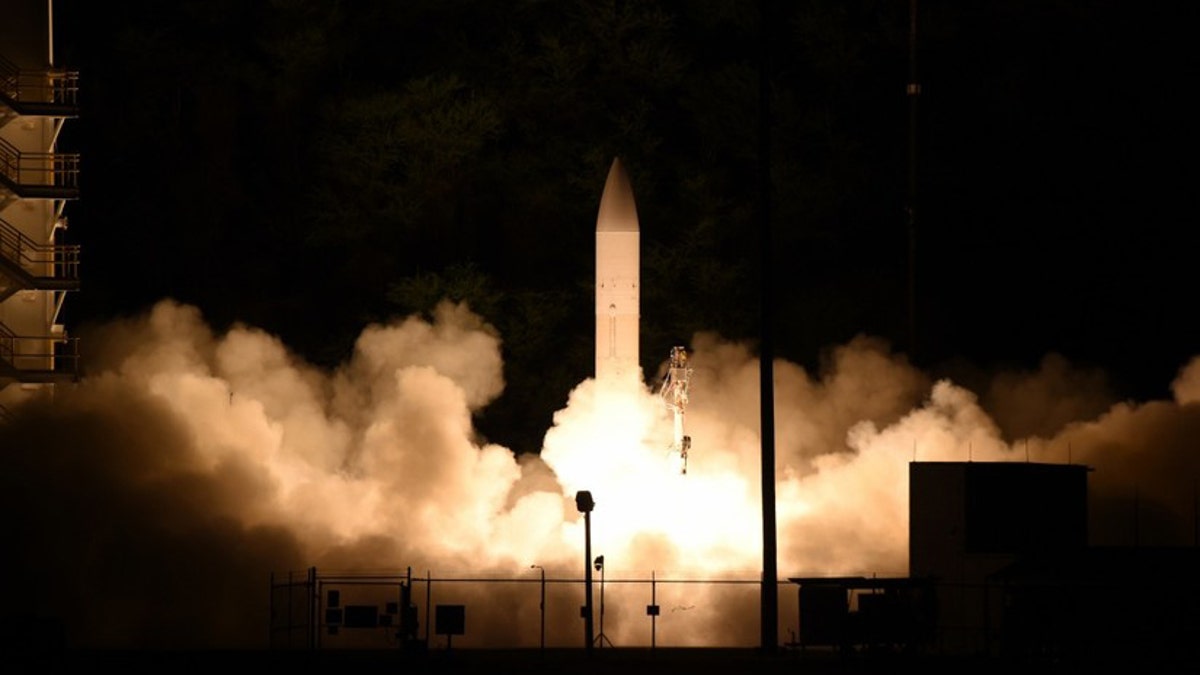
The DoD test. (Department of Defense)
The Army, Navy and Pentagon fired off a new Hypersonic Glide Body engineered to travel more than five times the speed of sound and destroy enemy targets thousands of miles away in a matter of minutes, a Pentagon report said.
Hypersonic weapons development, massively prioritized by the Pentagon, has been on the fast track in recent years; the first operational hypersonics are slated to be operational as soon as this year.
While there are not a lot of details related to the experimental firing at the moment, many are likely not available due to security and data-gathering reasons, the Pentagon report did say the Common Hypersonic Glide Body flew “at hypersonic speed to a designated impact point.” The shot was fired March 19, from the Pacific Missile Range Facility, Kauai, Hawaii.
PENTAGON DEPLOYS NEW SUB-LAUNCHED, LOW-YIELD NUCLEAR MISSILE
As a common body, the emerging weapon is intended to support both Army and Navy hypersonics weapons programs, as a way to lower costs, increase efficiency and speed up development.
While today's cruise missiles travel at speeds up to 600 miles per hour, hypersonic weapons will be able to reach speeds of Mach 5 to Mach 10, Air Force officials said. Senior Air Force officials have also said that hypersonic flight could speed up a five- hour flight from New York to Los Angeles to about 30 minutes.
All the services have been moving quickly to accelerate hypersonic weapons development. Last year, for instance, the Air Force conducted its first prototype hypersonic missile flight test; the service launched a sensor-only prototype of the AGM-183A Air Launched Rapid Response Weapon from a B-52.
PENTAGON GIVES F-22S 'FIRST STRIKE' CAPABILITY WORLDWIDE WITH RAPID RAPTOR PROGRAM
The advantages of these weapons are both self-evident and multi-faceted; they include much greater stand-off ranges for attack as well as a vastly increased ability to defeat, circumvent or even destroy enemy defenses. Hypersonic attack naturally reduces any kind of response time afforded to an enemy, possibly hitting or disabling a target before an enemy has a chance to respond. A weapon traveling at hypersonic speeds, naturally, would better enable offensive missile strikes to destroy targets such as enemy ships, buildings, air defenses and even drones and fixed-wing or rotary aircraft depending upon the guidance technology available.
Vice Adm. Johnny R. Wolfe, director of the Navy's Strategic Systems Programs said “we validated our design and are now ready to move to the next phase towards fielding a hypersonic strike capability,” according to the Pentagon report.
Hypersonic weapons development includes the testing of how advanced propulsion can power a scramjet vehicle to hypersonic speeds, and “boost glide” hypersonic vehicle weapons such as those used in this March 19 experiment. With “boost glide” technology, weapons are fired up into the sky along the boundary of the earth’s atmosphere.… before utilizing the speed of descent to strike targets as a re-entry vehicle.
PENTAGON APPROACHES MASSIVE NEW AI, MACHINE LEARNING BREAKTHROUGH
Many “boost glide” hypersonic weapons are engineered as “kinetic energy” strike weapons, meaning they will not use explosives but rather rely upon sheer speed and the force of impact to destroy targets, developers explain. In the future, perhaps as far away as several decades, super high-speed hypersonic recoverable drones could emerge, Air Force scientists have told Warrior. A hypersonic ISR (Intelligence, Surveillance and Reconnaissance) platform would better enable air vehicles to rapidly enter and exit enemy territory and send back relevant imagery without being detected by enemy radar or shot down.
Air-Breathing systems regularly use a scramjet engine to generate thrust -- and propel the air vehicle across long distances to a target. While engineered to reach previously unattainable levels of propulsion, scramjet engine technology aligns with the technical configuration of existing high-power engine systems. This includes taking in a high-speed airflow, compressing the air and then igniting it with gas or some kind of propellant to generate thrust.
Flight tests, demonstrations, ground testing and advanced air-vehicle configuration prototyping have been providing data for an Air Force, DARPA and Raytheon hypersonic weapons program called Hypersonic Air-Breathing Weapons Concept, or HAWC. DARPA statements on the program, citing program manager Andrew Knoedler, identify key areas of developmental emphasis to include “hydrocarbon scramjet-powered propulsion to enable sustained hypersonic cruise.” DARPA information, mirrored by what Raytheon weapons developers tell Warrior, explains that “sustaining” speeds at 5-times the speed of sound is a technical characteristic to hypersonic weapons...and the HAWC in particular.
CLICK HERE TO GET THE FOX NEWS APP
Following this recent test, there is more to come, U.S. Army LTG Neil Thurgood, Director of Hypersonics, Directed Energy, Space and Rapid Acquisition, said in the Pentagon report. “We will continue to move aggressively to get prototypes to the field," he said.
